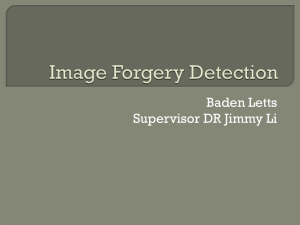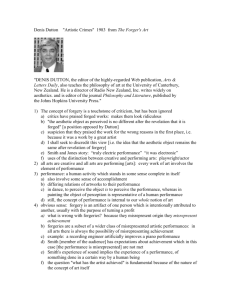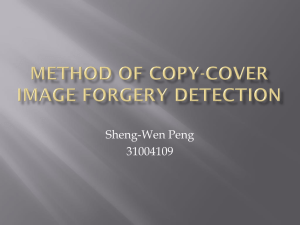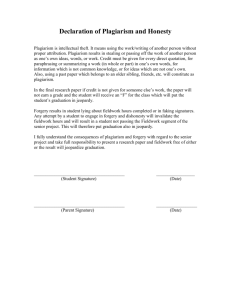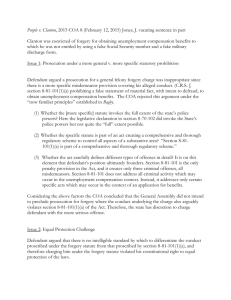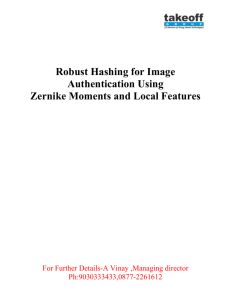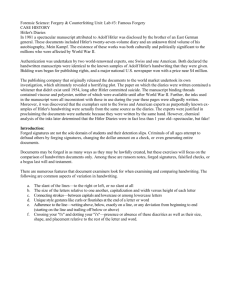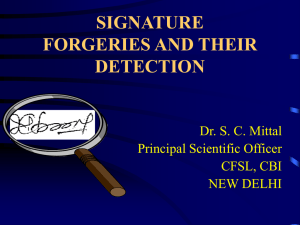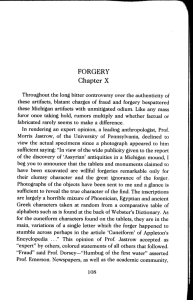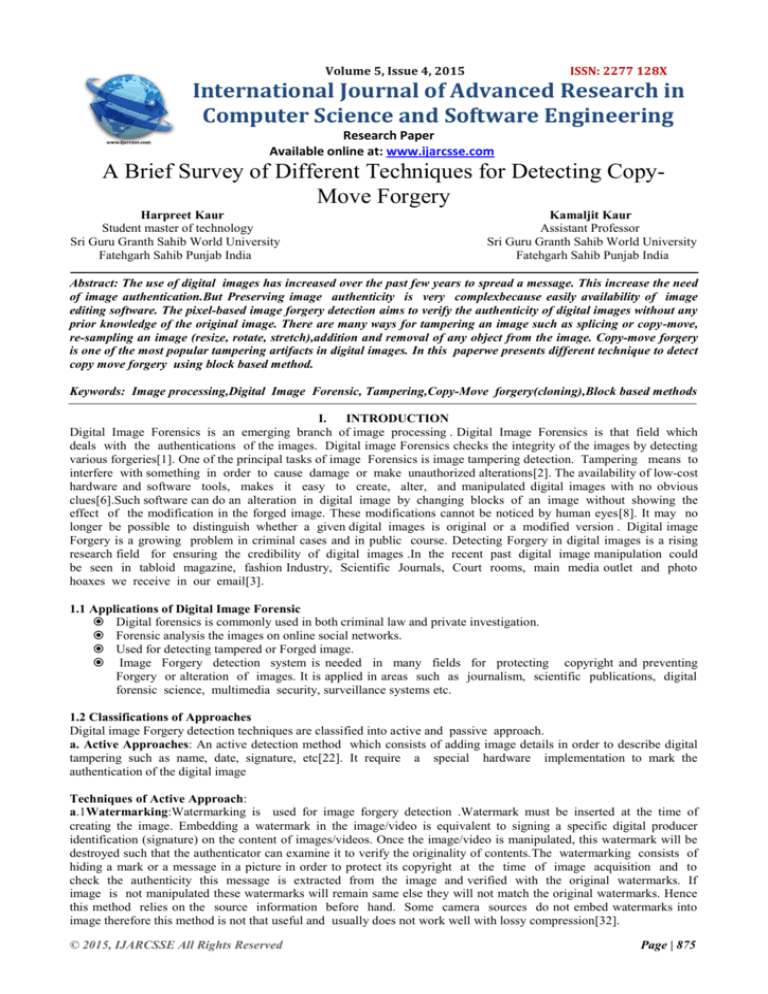
Volume 5, Issue 4, 2015
ISSN: 2277 128X
International Journal of Advanced Research in
Computer Science and Software Engineering
Research Paper
Available online at: www.ijarcsse.com
A Brief Survey of Different Techniques for Detecting CopyMove Forgery
Harpreet Kaur
Student master of technology
Sri Guru Granth Sahib World University
Fatehgarh Sahib Punjab India
Kamaljit Kaur
Assistant Professor
Sri Guru Granth Sahib World University
Fatehgarh Sahib Punjab India
Abstract: The use of digital images has increased over the past few years to spread a message. This increase the need
of image authentication.But Preserving image authenticity is very complexbecause easily availability of image
editing software. The pixel-based image forgery detection aims to verify the authenticity of digital images without any
prior knowledge of the original image. There are many ways for tampering an image such as splicing or copy-move,
re-sampling an image (resize, rotate, stretch),addition and removal of any object from the image. Copy-move forgery
is one of the most popular tampering artifacts in digital images. In this paperwe presents different technique to detect
copy move forgery using block based method.
Keywords: Image processing,Digital Image Forensic, Tampering,Copy-Move forgery(cloning),Block based methods
I.
INTRODUCTION
Digital Image Forensics is an emerging branch of image processing . Digital Image Forensics is that field which
deals with the authentications of the images. Digital image Forensics checks the integrity of the images by detecting
various forgeries[1]. One of the principal tasks of image Forensics is image tampering detection. Tampering means to
interfere with something in order to cause damage or make unauthorized alterations[2]. The availability of low-cost
hardware and software tools, makes it easy to create, alter, and manipulated digital images with no obvious
clues[6].Such software can do an alteration in digital image by changing blocks of an image without showing the
effect of the modification in the forged image. These modifications cannot be noticed by human eyes[8]. It may no
longer be possible to distinguish whether a given digital images is original or a modified version . Digital image
Forgery is a growing problem in criminal cases and in public course. Detecting Forgery in digital images is a rising
research field for ensuring the credibility of digital images .In the recent past digital image manipulation could
be seen in tabloid magazine, fashion Industry, Scientific Journals, Court rooms, main media outlet and photo
hoaxes we receive in our email[3].
1.1 Applications of Digital Image Forensic
Digital forensics is commonly used in both criminal law and private investigation.
Forensic analysis the images on online social networks.
Used for detecting tampered or Forged image.
Image Forgery detection system is needed in many fields for protecting copyright and preventing
Forgery or alteration of images. It is applied in areas such as journalism, scientific publications, digital
forensic science, multimedia security, surveillance systems etc.
1.2 Classifications of Approaches
Digital image Forgery detection techniques are classified into active and passive approach.
a. Active Approaches: An active detection method which consists of adding image details in order to describe digital
tampering such as name, date, signature, etc[22]. It require a special hardware implementation to mark the
authentication of the digital image
Techniques of Active Approach:
a.1Watermarking:Watermarking is used for image forgery detection .Watermark must be inserted at the time of
creating the image. Embedding a watermark in the image/video is equivalent to signing a specific digital producer
identification (signature) on the content of images/videos. Once the image/video is manipulated, this watermark will be
destroyed such that the authenticator can examine it to verify the originality of contents.The watermarking consists of
hiding a mark or a message in a picture in order to protect its copyright at the time of image acquisition and to
check the authenticity this message is extracted from the image and verified with the original watermarks. If
image is not manipulated these watermarks will remain same else they will not match the original watermarks. Hence
this method relies on the source information before hand. Some camera sources do not embed watermarks into
image therefore this method is not that useful and usually does not work well with lossy compression[32].
© 2015, IJARCSSE All Rights Reserved
Page | 875
Harpreet et al., International Journal of Advanced Research in Computer Science and Software Engineering 5(4),
April- 2015, pp. 875-882
Water mark image
Original Image
Watermarked original image
Watermarked original image
(Watermark over the whole image)
(Watermark at the corner)
Fig1 Example of Watermarking[33]
a2.Digital Signatures: Digital signature is some sort of cryptographic is a mathematical scheme for demonstrating
the authenticity of digital document[6].It generates a content-based digital signature which includes the important
information of contents and the exclusive producer identification .The signature is generated by a producer-specific
private key such that it can not be forged. Therefore, the authenticator can verify a received image/video by examining
whether its contents match the information conveyed in the signature .
Fig2 Signature Generator and Image Authentication Process[31]
© 2015, IJARCSSE All Rights Reserved
Page | 876
Harpreet et al., International Journal of Advanced Research in Computer Science and Software Engineering 5(4),
April- 2015, pp. 875-882
A signature and an image are generated at the same time. The signature is an encrypted form of the feature codes
orhashes of this image, and it is stored separately. Once a user needs to authenticate the image he receives, he
shoulddecrypt this signature and compare the feature codes (or hash values) of this image to their corresponding values in
the original signature. If they match, this image can be claimed to be “authentic”[31] .
Advantage of Active Approach:
Computational cost less ,simpleif knowledge about original image is available.
Disadvantage of Active Approach:
These techniques require prior knowledge about original image thus they are not automatic.They required
some human intervention or specially equipped cameras.
There are more than millions of digital images in internet without digital signature or watermark. In
such scenario active approach could not be used to find the authenticity of the image[7].
In Digital Signature scheme, Extra Bandwidth is needed for transmission of Signature
b.Passive Approach:Passive method detects the duplicated objects in forged images withoutneed of original image
watermarkand depends on traces left on the image by different processing steps during image manipulation. Passive
approach also determines the amount and the location of forgery in the image. There are two methods of passive
approach.
Image source identification- It identifies the device used for the acquisition of the digital image. It tells that the image
is computer generated or digital camera image. In this method the location of forgery in image cannot be determined.
Tampering detection- It detects the intentional manipulation of images for malicious purposes. Image
manipulation is denoted as tampering when it aims at modifying the content of the visual message[32].
Techniques of Passive Approach:
b1.. Pixel-based techniques that detect statistical anomalies introduced at the pixel level.
b2. Format-based techniques that leverage the statistical correlations introduced by a specific lossy compression
scheme.
b3. Camera-based techniques that exploit artifacts introduced by the camera lens, sensor, or on-chip post-processing.
b4. Physically based techniques that explicitly model and detect anomalies in the three-dimensional interaction
between physical objects, light, and the camera.
b5. Geometric-based techniques that make measurements of objects in the world and their positions relative to the
camera [5].
Advantage of passive approach:
Pre existing digital images and data cannot gain any profit using Active approach. Passive approach overcomes
this disadvantage; the pre-existing images can also be catered using this approach.
Disadvantage of passive approach:
These techniques based on the assumption that digital forgeries may leave no visual clues that indicate
tampering,so they require different statistics of an image. Thus it is complex.
1.3 Types of Digital Image Forgery
The forgeries are classified into five major categories
Image Retouching
Image Splicing
Copy-Move (cloning)
Morphing
Enhanced
Image Retouching: where the method is used for enhances an image or reduces some feature of an image and
enhances the image quality for capturing the reader's attention. In this method, the professional image editors change
the background, fill some attractive colors, and work with hue saturation for toning and balancing.
Image Splicing: where the different elements from multiple images are combined in a single. Such splicing can
usually be detected by searching the splicing boundary (or the effect of the splicing on image statistics )
Copy-Move:In the copy move a part of the image is copied and pasted somewhere else within the same image. This
method usually for hide definite particulars or to matching convinced features of an image. The blur tool is use for
retouching borders and decrease the effect between original and pasted area [23].
Morphing: In this type the image and video can be exposed into unique influence ,where the one object on image is
turned into another object in the other image. The morphing is used to transfer the one-person image from
another person image by using seamless transition between two images.
© 2015, IJARCSSE All Rights Reserved
Page | 877
Harpreet et al., International Journal of Advanced Research in Computer Science and Software Engineering 5(4),
April- 2015, pp. 875-882
Image
In this method, the image
Retouching
editors
change
the
background,
fill
some
attractive colors, and work
with hue saturation for
toning and balancing[23].
Original Image
Image
Splicing
where
the
different
elements from multiple
images are combined in a
single.[25]
CopyMove
(cloning)
In the copy move a part of
the image is copied and
pasted somewhere
else
within the same image.[24]
Morphing
The morphing is used to
transfer the
one-person
image from another person
image by using seamless
transition
between
two
images[23].
Enhanced
The
original
image is
forged
by enhanced image with
color change, perform blur
on background[22]
Original Image
Original Image
Forged Image
Original Image
Forged Image
Forged Image
Original Image Forged Image
Original Image
Forged Image
Original Image
Fig3:Types of Digital Image Forgery
© 2015, IJARCSSE All Rights Reserved
Page | 878
Harpreet et al., International Journal of Advanced Research in Computer Science and Software Engineering 5(4),
April- 2015, pp. 875-882
II.
COPY-MOVE FORGERY DETECTION
Copy-Move image forgery is the widely used technique to edit the digital image.Copy-Move forgery is performed with
the intention to make an object “disappear” from the image by covering it with a small block copied from another part
of the same image. Since the copied segments come from the same image, the color palette, noise components, color
and the other properties will be same with the rest of the image, thus it is very difficult for a human eye to
detect[3].A copy move forgery is easy to create. The copied content of image which is used to perform forgery is
called snippet. As the source and the target regions are from the same image, the image features like noise,
color, illumination condition etc. will be same for the forged region and the rest of the image. A clever forger may also
do some post-processing on the copied region like rotation, scaling, blurring, noise addition before the region is
pasted. These factors make the forgery detection more complex. So the crucial point in such a forgery detection
technique would be extraction of features.[2]
Generally, Copy-Move forgery detection techniques can be classified into two: Block based approaches and Keypoint based approaches [7]. In both the approaches some form of pre-processing will be there.Unlike blockbased methods, Keypoint based methods compute their features only on image regions with high entropy, without
any image subdivision for do not divide the image into blocks to extract the features instead, the features are
extracted from the whole image.There are two types of keypoint based methods such as Scale Invariant Feature
Transform (SIFT) and Speeded Up Robust Features (SURF). Block-based methods subdivide the image into
overlapping blocks of specified size for feature extraction. Similar feature vectors are subsequently matched. There
are 13 block-based features and it can be grouped into four categories: Moment-based (Blur[13], Hu, Zernike[12]),
Dimensionality reduction-based (PCA [5], SVD[11], KPCA ), Intensity-based (Luo[10],Lin,Bravo, Circle[14]),
Frequency -based (DCT [8] [9], DWT, FMT [12]).
III.
PREVIOUS WORK DONE
In the last decade, many passive detection schemes for copy-move forgery have been proposed. Fridrich [8] first
proposed a method of detecting copy-move forgery using discrete cosine transform (DCT) of overlapping blocks
. Popescu [9] presented a method using principal component analysis (PCA) for the representation of image
segments i.e. overlapping square blocks DCT. Luo [10] introduced a copy-move forgery detection and localization
method based on dividing an image into small overlapped blocks, then comparing the similarity of these blocks
and finally identifying possible duplicated regions using intensity based characteristics features.The algorithm has
lower computational complexity and is more robust against stronger attacks and various types of after-copying
manipulations, such as lossy compression, noise. A different approach was presented by Kang [11] in which the
features were represented by the singular value decomposition (SVD). In this method the correlation is used for
copied and pasted areas and for searching equal regions.Bayram [12] applied Fourier-Mellin transform (FMT) to each
block and FMT values were finally projected to one dimension to form the feature vector. Mahdian [13] used a
method based on blur moment invariants to locate the forgery regions. Li [14] extracted the features of the circular
blocks using rotation invariant uniform local binary patterns.Reference [16] the image is subdivided into circular
blocks . Polar sine transform is used to extract features and feature matrix is sorted.In 2012, [28] proposed a
method using dyadic wavelets. Undecimated dyadic wavelets were chosen because of their property of shift
invariance .The work in [29] forward a method using DCT and circular blocks in 2012. After block subdivision
DCT is applied to each block. As in DCT, the energy concentrates on low frequency coefficients; a circle block
representation is adopted for each block. A circle block is divided into four quadrants and features extracted
from each quadrant.Another work [30] in 2013 presented a method that takes only low frequency part of the image
by performing a Gaussian pyramids decomposition. Low frequency part will be half the size of the image. Mixed
moments are computed for the overlapping b x b sub-blocks whose total count will be Y= ([M/2]-b+1) x
([N/2]-b+1).In another method [24] the Guassian pyramid are used for image dimensions for circle block and
analyzed four features.The image separated into many fixed sized blocks that and further coinciding and calculate the
reign values through Hu moments. A recent method based of expanding blocks was proposed in [31] in 2013. In their
approach they used the direct block comparison instead of comparison based on block features.Blocks are
compared against blocks in the same bucket only. A block is eliminated from the bucket if it does not match with
any other block in the bucket. Blocks with no matches are eliminated, the search region is expanded and the
comparison is continued. As the region expands the number blocks in the bucket reduces and remaining blocks
are considered as part of the copied region.
Sr no.
1
IV.
Author/year
J. Fridrich 2003[8]
2
Popescu,2004[9]
3
W.
Q.
2006[10]
Luo
COMPARISON BETWEEN EXISTING TECHNIQUES
Methodology Advantage
Disadvantage
DCT
Copy-move region is
Will not work in noisy
Detected
Image
PCA
Efficient method, low false Low efficiency for low quality
positives
of image, low
SNR and small blocks.
Similarity
Copy-move region
Time complexity isReduced
matching
detected in noisy
conditions
© 2015, IJARCSSE All Rights Reserved
Page | 879
Harpreet et al., International Journal of Advanced Research in Computer Science and Software Engineering 5(4),
April- 2015, pp. 875-882
4
G. H. Li 2007
DWT-SVD
Efficiently detects
Time
complexity
isless
forged region
compared to
other algorithms
5
Mahdian,2007[13]
BLUR
Duplicated regions detect with
High computation time of the
changed contrast values and algorithm
blurred
regions can also be detected
J. Zhang 2008
DWT
Exact copy-move
Works well in noisyand
6
region is detected
compressed
Image
7
H. Huang 2008
SIFT
Copy-move region is detected
Detects false result also
8
X. Kang 2008[11]
SVD
9
Wang, 2009,
CIRCLE
10
H.-J. Lin 2009
Improved
PCA
11
Z. Lin 2009
12
Ting, 2009,
.
Double
Quantization
DCT
SVD
13
Bayram, 2009[12]
FMT
14
Wang,2009,
HU
15
Qiao, 2011,
CURVELET
16
M. Ghorbani 2011
DCT-DWT
17
S. D. Lin 2011
DCT-SURF
18
Muhammad
2012[28]
19
Cao Y 2012[29]
,
Dy DWT
Circular
Block
with DCT
© 2015, IJARCSSE All Rights Reserved
Copy-Move region isdetected
accurately
Working for post-processinglike
blurring, rotating, noise adding
etc.
Exact
Copy-Moveregion
is
detectedWorks well in noisy,
compressed image
Tampered region isdetected
accurately
Can detect duplication even
postprocessing is done, robust
and
computationally less complex
Efficient and robust to blurring,
noise, scaling, lossy JPEG
compression and translational
effects.
Robust and efficient method,
detects
post-processing effects like noise
addition,
blurring,
lossy
compression
etc.
Multi-dimensional
and
multidirectional gives precise
results.
Forged region is
Detected accurately
Copy-Move and
spliced both region
detected
Reduced false
positives.
Advantageous
than previous
methods
using DWT
Perfect
detection for
uniform
background
images, non regular duplicate
regions, high
resolution images.
Detect multiple
copies -move
Will not work in
highly noised &
compressed image
Scaling and geometric
transformations cannot be
detected.
Works only in JPEG
Format
Cannot detect
Regions
copy
paste
Cannot detect forgeries,
which have rotation of
above 10 degrees and
scaling of 10%.
Many False positives
Cannot be applied on
compressed images.
Will not work in highly
compressed image
Tested only for
small rotation
angle and good
quality images
Poor
performance
with poor image
quality. Not
robust to
geometrical
operations
Page | 880
Harpreet et al., International Journal of Advanced Research in Computer Science and Software Engineering 5(4),
April- 2015, pp. 875-882
20
LGavin, 2013[31]
Expanding
Detection
Slow in
Blocks
with irregularly
execution.
shaped regions and for forged
Number of false
regions slightly
positives more
darkened or
when compared
lightened.
to other
methods.
21
Mohamadian,2013 ZERNIKE
Flat regions of forgeries are Calculating Zernike
[28]
detected
moment coefficients is
complex
22
Zhong L 2013[30] Mixed
Tested for
Qualitative
Moments
rotation, scaling,
evaluation not
brightness
specified
enhancement,
Rotation angle and
contrast changes.
scaling factor not
Reduced number of
specified.
Blocks
23
Zhu H, 2013[16]
Polar
Addressed
Simulation
harmonic
affine
results only
transform
transforms
available
like shearing
and perspective
projections
that were rarely
considered before
V.
CONCLUSION
Copy-Move forgery detection in digital images is more prevalent problem during the past two or three decades. Many
techniques have been proposed to address this problem. This paper providebrief survey to detect copy move forgery
detection method. This also covers limitations of different techniques used for passive method to detect copy move
forgery. The comparative work can be extended by proposing a novel technique with which the existing limitations can
be overcomed.
REFERENCES
[1]
MohdDilshad Ansari, S. P. Ghrera&VipinTyagi :"Pixel-Based Image Forgery Detection: A Review" IETE
Journal of Education, 40-46(Aug 2014)
[2]
ResmiSekhar,Chithra AS:" Recent Block-based Methods of Copy-Move Forgery Detection in Digital Images"
International Journal of Computer Applications (0975 – 8887),Volume 89 , no. 8, March 2014.
[3]
Rohini.A.Maind, AlkaKhade, D.K.Chitre:" Image Copy Move Forgery Detection using Block Representing
Method" International Journal of Soft Computing and Engineering (IJSCE)ISSN: 2231-2307, Volume-4, Issue2, May 2014.
[4]
Ms. P. G.Gomase, Ms. N. R. Wankhade:" ADVANCED DIGITAL IMAGE FORGERY DETECTION: A
REVIEW"Journal of Computer Science (IOSR-JCE) e-ISSN: 2278-0661, PP 80-83.
[5]
HanyFarid, ”Image Forgery Detection”, IEEE SIGNAL PROCESSING MAGAZINE, pp. 16-25, MARCH
2009.
[6]
Nikhilkumar P. Joglekar, Dr. P. N. Chatur"A Compressive Survey on Active and Passive Methods for Image
Forgery Detection"International Journal Of Engineering And Computer Science ISSN:2319-7242 ,Volume 4 ,
Page No. 10187-10190, 1 January 2015. Tushant A. Kohale
[7]
Dr. S.D. Chede, Prof. P.R.Lakhe" Forgery of Copy Move Image Detection Technique by Integrating Block and
Feature Based Method" International Journal of Advanced Research in Computer and Communication
Engineering Vol. 4, Issue 1, January 2015
[8]
J. Fridrich, D. Soukalm and J. Lukas, “Detection of Copy-Move Forgery in Digital Images, Digital Forensic
Research Workshop, Cleveland, (2003), pp. 19–23.
[9]
A. C. Popescu and H. Farid, “Exposing Digital Forgeries by Detecting Duplicated Image Regions”,
Tech. Rep. TR2004-515, Dartmouth College, (2004).
[10]
W. Luo, J. Huang and G. Qiu, “Robust detection of region-duplication forgery in digital images”, in:
International Conference on Pattern Recognition, vol. 4, (2006), 746–749.
[11]
X. Kang and S. Wei, “Identifying tampered regions using singular value decomposition in digital image
forensics”, in: Proceedings of International Conference on Com-puter Science and Software Engineering,
(2008), pp. 926–930.
[12]
S. Bayram, H. T. Sencar and N. Memon, “An efficient and robust method for detecting copy-move forgery”,
in: IEEE International Conference on Acoustics, Speech and Signal Processing, IEEE Press, New
York,(2009).
© 2015, IJARCSSE All Rights Reserved
Page | 881
Harpreet et al., International Journal of Advanced Research in Computer Science and Software Engineering 5(4),
April- 2015, pp. 875-882
[13]
B. Mahdian and S. Saic, “Detection of copy-move forgery using a method based on blur moment invariants”,
Forensic Sci. Int., vol. 171, (2007) pp. 180–189.
[14]
L. Li, S. Li, H. Zhu, S.-C. Chu, J. F. Roddick, and J.-S. Pan, “An Efficient Scheme for Detecting Copy-move
Forged Images by Local Binary Patterns”, Journal of Information Hiding and Multimedia Signal Processing,
vol. 4, no. 1, (2013) January, pp. 46-56.
[15]
G. Lynch, F. Y. Shih and H. M. Liao, “An efficient expanding block algorithm for image copy-move forgery
detection”, Inf. Sci., vol. 239, (2013), pp. 253–265.
[16]
Li L, Li S, Zhu H, Wu X. “Detecting copy-move forgery under affine transforms for image forensics”,
Computer Electric Eng (2013)
[17]
Cheng Yan ”Research on Forged Identification of Forged Images”, International
Conference on
Mehatronic Sciences,Electric Engineering and Computer,20 dec 2013
[18]
Ashima Gupta, NisheethSaxena, S.K Vasisth,”Detecting Copy Move Forgery Using DCT”, International
Journal of Scientific and Research Pulication,Vol.3,Issue5,May 2013
[19]
Amanpreet Kaur ,Richa Sharma ,” Optimization of Copy-Move Forgery Detection Technique”, International
Journal of Advanced Research in Computer Science and Software Engineering , Vol 3, Issue 4, April 2013
[20]
Wei Hou, ZheJi, Xin Jin, Xing Li, "Double JPEG Compression Detection Based on Extended First Digit
Features of DCT Coefficients",International Journal of Information and Education Technology, Vol. 3, No. 5,
October 2013
[21]
Abhitha.E, V.J Arul Karthick, "Forensic Technique for Detecting Tamper in Digital Image Compression",
International Journal of Advanced Research in Computer and Communication Engineering Vol.2, Issue3,March
2013
[22]
Salam A.Thajeel and Ghazali Bin Sulong,"STATE OF THE ART OF COPY-MOVE FORGERY DETECTION
TECHNIQUES: A REVIEW",International Journal of Computer Science Issues, Vol. 10, Issue 6, No 2,
November 2013
[23]
H. SHAH, P. SHINDE, AND J. KUKREJA,"RETOUCHING DETECTION AND STEGANALYSIS,"
IJEIR, VOL. 2, PP. 487-490, 2013
[24]
SALAM A.THAJEEL,GHAZALI SULONG,"A SURVEY OF COPY-MOVE FORGERY DETECTION
TECHNIQUES",Journal of Theoretical and Applied Information Technology. Vol.70 , 10thDecember 2014
[25]
Mariam Saleem,"A Key-Point Based Robust Algorithm for Detecting Cloning Forgery",International Journal of
Current Engineering and Technology,Vol.4, No.4 (Aug 2014).
[26]
M. Sridevi, C. Mala, AND S. Sandeep ,"COPY–MOVE IMAGE FORGERY DETECTION IN A
PARALLEL ENVIRONMENT," 2012.
[27]
J. Fridrich, D. Soukal, and J. Lukas,“Detection of copy move forgery in digital images,”in Proceedings of the
Digital Forensic Research Workshop, Aug. 2003, pp. 5-8.
[28]
Muhammad, G., Hussain, M., Bebis, G., “Passive copy move image forgery detection using undecimated
dyadic wavelet transform”, Digital Investigation (9), 2012.
[29]
Cao Y, Gao T, Fan L, Yang Q., “A robust detection algorithm for copy-move forgery in digital images”,
Forensic Sci Int. 2012 Jan.
[30]
Zhong L, Xu W, “A robust image copy-move forgery detection based on mixed moments”, IEEE
International Conference on Software Engineering and Service Sciences (ICSESS), 2013 May.
[31]
L Gavin, S Frank, L Hong-Yuan Markl, “An efficient expanding block algorithm for image copy-move
forgery detection”, Information Sciences 239, 2013.
[32]
Amanpreet Kaur,RichaSharma"Copy-Move Forgery Detection using DCT and SIFT",International Journal of
Computer Applications (0975 – 8887) Volume 70– No.7, May 2013
[33]
A Project Report on Watermarking of Digital Images by Saraju Prasad Mohanty
© 2015, IJARCSSE All Rights Reserved
Page | 882

